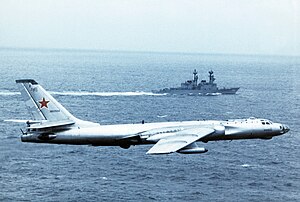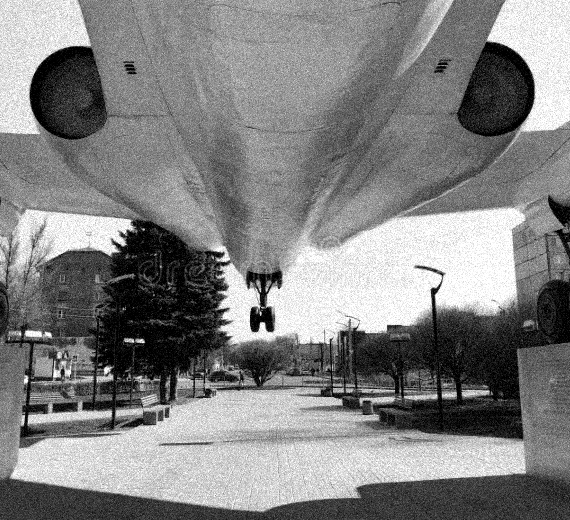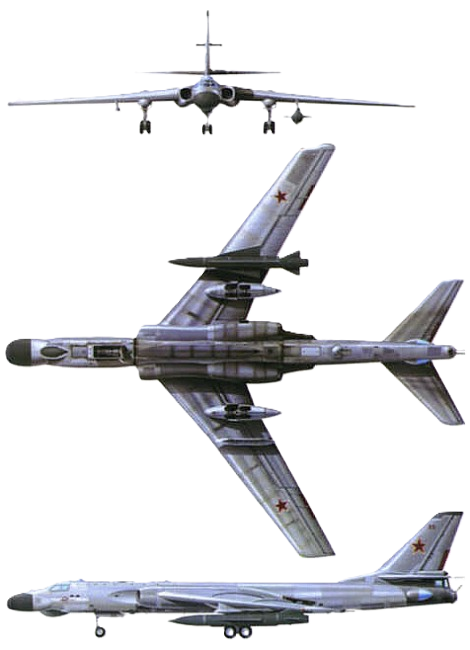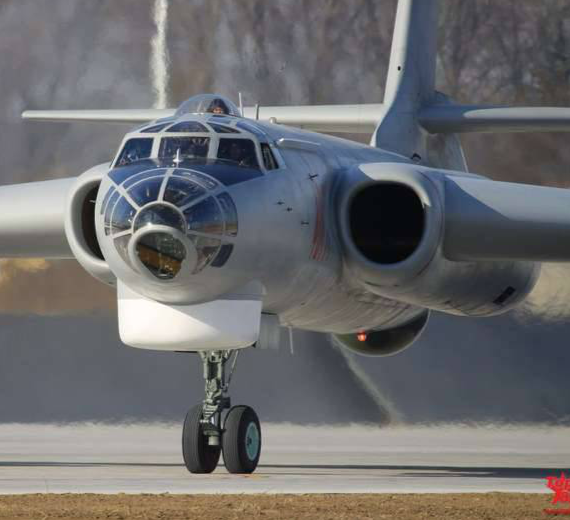Tupolev Design Bureau Tupolev Tu-16 Badger
 |
|
| A Tu-16 in flight over USS Hewitt (circa 1978) | |
| Role | Strategic bomber |
|---|---|
| National origin | Soviet Union |
| Manufacturer | Voronezh Aircraft Production Association |
| Designer | Tupolev |
| First flight | 27 April 1952 |
| Introduction | 1954 |
| Status | Discontinued, In limited service |
| Primary users | Russian Air Force Egyptian Air Force (Historical) Iraqi Air Force (Historical) Indonesian Air Force (Historical) |
| Produced | 1952–1962 |
| Number built | 1,509 |
| Variants | Tupolev Tu-104 Tupolev Tu-124 Xian H-6 |
|
|
.
History Public Joint Stock Company Tupolev,
Tupolev Tu-16 (USAF/DOD reporting name Type 39;
NATO reporting name: Badger)

The Tupolev Tu-16 (USAF/DOD reporting name Type 39; NATO reporting name: Badger) is a twin-engined jet strategic heavy bomber used by the Soviet Union. It has been flown for almost 70 years. While many aircraft in Soviet service were retired after the Cold War ended, the Chinese license-built version Xian H-6 remains in service with the People's Liberation Army Air Force, with more being built as of 2020
Development

In the late 1940s, the Soviet Union was strongly committed to matching the United States in strategic bombing capability. The Soviets' only long-range bomber at the time was Tupolev's Tu-4 'Bull', a reverse-engineered copy of the American B-29 Superfortress. The development of the notably powerful Mikulin AM-3 turbojet led to the possibility of a large, jet-powered bomber.
0
KmCeiling
0
KmCombat RANGE
0
Km.hAircraft Speed
0
Max Crew
Photo Gallery
Tupolev Tu-16 (USAF/DOD reporting name Type 39; NATO reporting name: Badger)


Public Joint Stock Company Tupolev,
Tupolev Tu-16 (USAF/DOD reporting name Type 39; NATO reporting name: Badger)
General Info
-
-
-
-
- Crew: 6-7
- Length: 34.80 m (114 ft 2 in)
- Wingspan: 33.00 m (108 ft 3 in)
- Height: 10.36 m (34 ft 0 in)
- Wing area: 165 m2 (1,780 sq ft)
-
-
-
Powerplant
-
-
-
-
- Empty weight: 37,200 kg
- Gross weight: 76,000 kg
- Max takeoff weight: 79,000 kg
- Powerplant: 2 × Mikulin AM-3 M-500 turbojets, 93.2 kN (21,000 lbf) thrust each
-
-
-
Performance
-
- Maximum speed: 1,050 km/h
- Range: 7,200 km
- Service ceiling: 12,800 m
- Wing loading: 460 kg/m2 (94 lb/sq ft)
Related development
-
- Guns: 6–7 × 23 mm Afanasev Makarov AM-23 cannons, two each in dorsal and ventral remote turrets and manned tail turret, with the occasional addition of one fixed forward in the nose
- Hardpoints: 2 Underwing hardpoints for missiles and a bomb bay for missiles or bombs (depending on variant)
-
- Bombs: Badger-A + Export versions 9,000 kg (20,000 lb) of free-fall weapons
.
Links to Youtube & Others
Among the main production variants of the Badger were the Tu-16 and Tu-16A bombers and Tu-16KS and Tu-16K-10 missile carriers, Tu-16SPS, "Elka", and Tu-16Ye ECM aircraft, Tu-16R reconnaissance aircraft, and Tu-16T torpedo bombers; others were produced from conversions. Individual aircraft could be modified several times, with designations changed, especially concerning missile-carrying aircraft.
Tupolev Design Bureau Tupolev Tu-16 Badger
A versatile design, the Tu-16 was built in numerous specialized variants for aerial reconnaissance, maritime surveillance,
Youtube Link
Delivery of the Tu-16 to China began in 1958, and the Xi'an Aircraft Industrial Corporation license-produced the aircraft under the Chinese designation Xian H-6.








.png)



